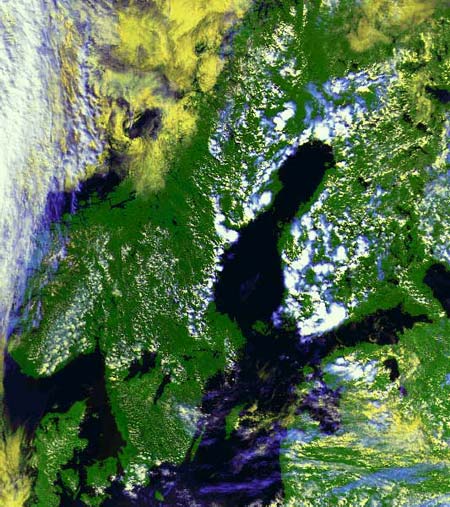Sea breeze - (n.)
The sea breeze is the familiar gentle wind from the sea that one experiences on a warm summer day. During hot summer days, it brings relief to coastal dwellers by blowing marine air inland. In the later afternoon, the sea breeze dies, and sometime at night the wind reverses, producing a land breeze. Sea and land breezes are caused by the difference in heat capacity of sea and land surface. During the day, when the sun shines both on the ocean and on the land surfaces, the land heats up much faster than the sea. The air above the land is heated from below and expands. As it expands, it becomes lighter than the surrounding air masses, and it rises. This same principle moves air up the smoke stacks and lifts hot-air balloons. The light rising air exerts less pressure on the land surface than did the air at equilibrium. Consequently, a low pressure center develops on the land surface. Air moves in from the periphery, along the pressure-gradient, from sea to land and the sea breeze is created. The rising air over the land, incidentally, keeps expanding and cools as it moves to ever-higher altitudes, until it begins to lose water, eventually forming clouds. On satellite photos,like the one below, the rising air is commonly clearly marked by puffy clouds over the coastal region, with a perfectly clear sky over the land.
One reason for the unequal heating of land and sea is obvious: the great heat capacity of water. It takes 1000 calories to raise the temperature of one kilogram of water by 1°C, but only 200 calories to do the same for one kilogram of rock. Thus, given a certain influx of heat from the sun's radiation, a rock will warm up about 5 times faster than water. Conversely, rock will also cool faster at night compared with water. Consequently, the pressure gradient in the air reverses at night. Another reason for the unequal heating is both more subtle and more important than specific heat: the surface of the ocean, as far as diurnal heating is concerned, is much thicker than that of the land. The sunlight readily penetrates the ocean surface, and light is absorbed within a layer more than 10 meters thick. The thickness of the soil layer which is warmed by the sun (by downward conduction of surface heat) is more like 10 centimeters. The land surface is effectively more than 100 times thinner than the sea surface. Depending on the wetness of the soil, it is between 100 and 500 times less resistant to temperature change than the sea surface, given a certain solar radiation input. This makes it clear why diurnal temperature ranges in the deserts of California can readily go over 30°C, while those of the nearby ocean will rarely exceed a fraction of one degree.

